With New Years Eve upon us, it’s obviously time to start thinking about Champagne. There are so many varieties, flavors, prices, and stemware to choose from, that you may feel a bit daunted. How does one choose the perfect champagne? That magical moment at midnight heralds a New Year bursting with opportunities and leaves all the old behind. We should treat the special occasion with the respect and deference it deserves.
Let’s start with a smidge of history.
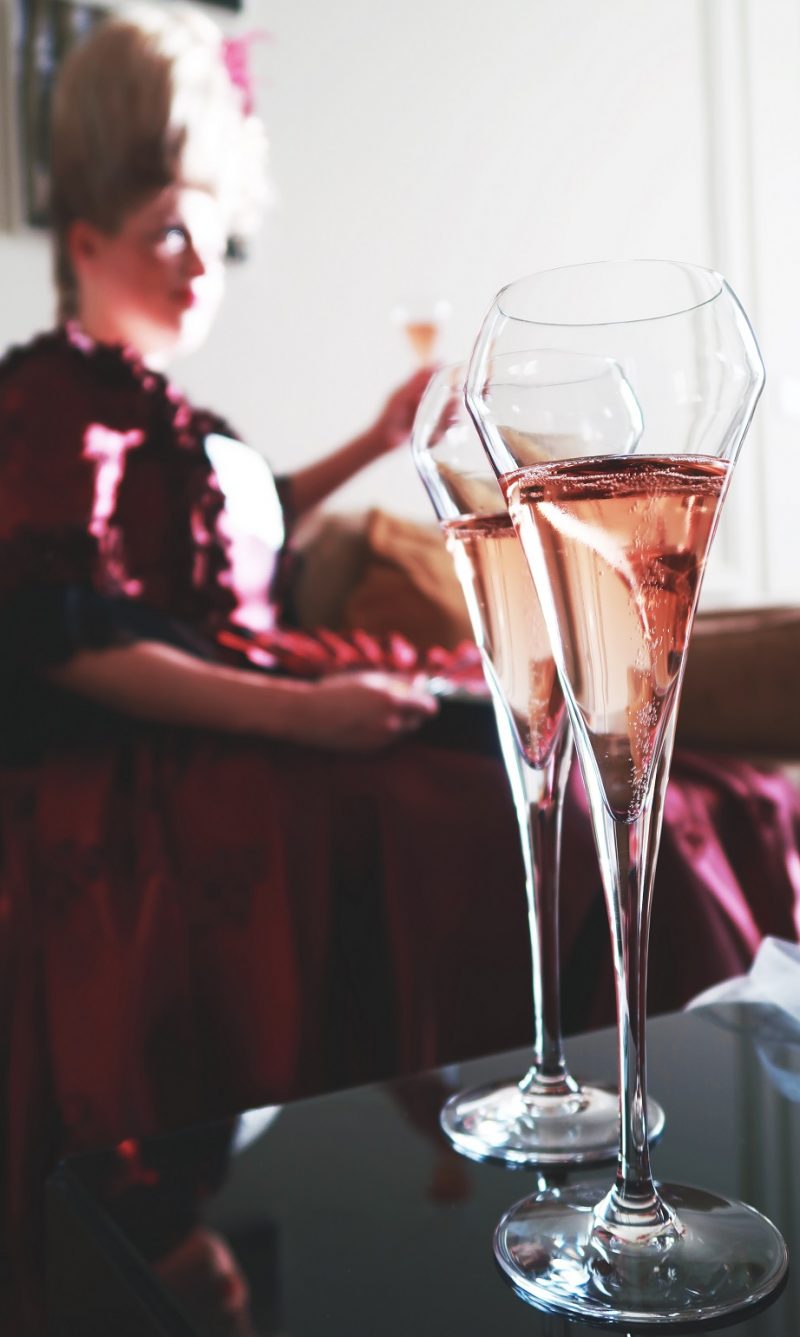
THE BIRTH OF BUBBLY
Made exclusively from wines in the Champagne region of Northern France, Champagne (with a capital “C”, thank you very much) has been enjoyed for centuries and, fellow Anglophiles will relish to learn, we owe it to the English for the sparkling beverage we know and love today [1]. While the name Dom Pérignon is highly regarded in today’s champagne market, the monk is probably turning in his grave now to see his wines purposefully imbued with fizz and bubbles galore. You see, the presence of bubbles in wine was once considered an egregious fault of the winemaker, and when Pérignon took charge of the vineyard in 1668, he made it his mission to develop techniques that would limit this blight from occurring.
Enter the English, with their flair for converting the inescapable nuisances of life into celebrated occurrences. Charles de Saint-Évremond, an epicurean, arrived in London society around 1661 and began touting the delicious wines of the Champagne region with a zest that caught the attention of many powerful and fashionable people of London. The wine was non-sparkling, that is, it was meant to be non-sparkling. However, the freezing temperatures during the winter seasons in Champagne would sometimes cause the fermentation process to halt before completion, which led to some residual sugars and dormant yeast left behind. After a rocky channel crossing to England in large wooden wine barrels, the wine would be bottled and corked, but the warm weather would naturally restart the fermentation process, and the wine would begin to build pressure from carbon dioxide gas. Then, when a bottle made it to a fancy London table and was opened, voila, it was bubbly.
HOW TO CHOOSE
Quick – which bottle is better?
|
Dom Pérignon Brut Vintage Champagne [2] |
$231.95 |
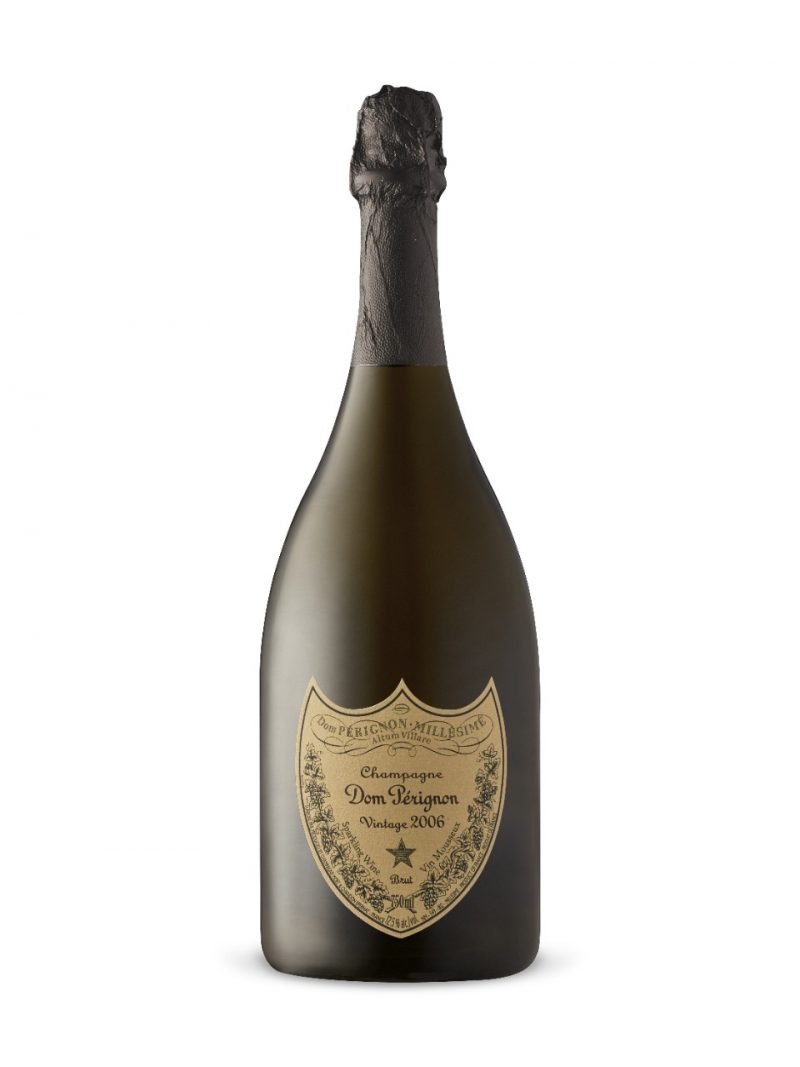 |
|
Jacob’s Creek Moscato Rosé Sparkling [3] |
$13.49 |
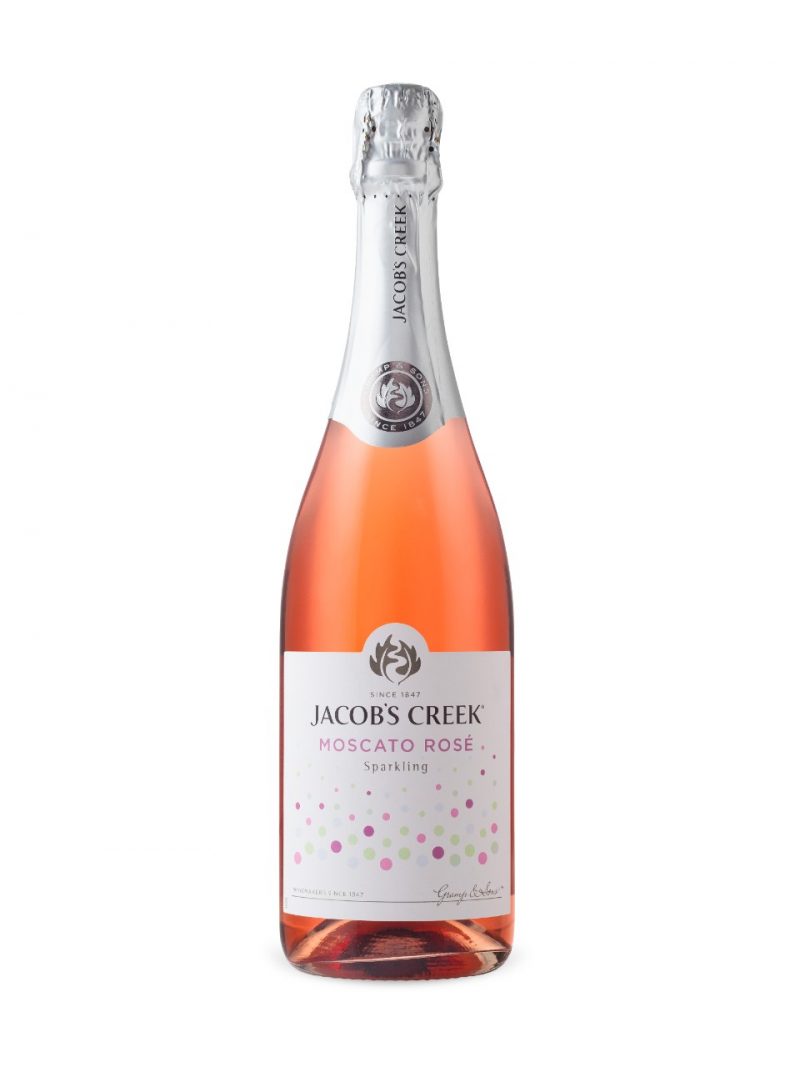 |
That was a trick question. Price isn’t everything. A high price tag won’t ensure you enjoy it if you don’t know what your own tastes are. For someone who prefers a sweeter glass, the Moscato will undoubtedly taste better on their palate than the drier, and heftier-priced, Champagne. Remember that Champagne with a capital “C” means it is specifically from the Champagne region of France, while champagne with a lower-case “c” comes from other regions or countries, and is usually labelled as a sparkling wine. Some regions have their own name for this type of bubbly beverage, such as Prosecco in Italy, or Cava in Spain.
To help guide your choices, consider the following terms when navigating the liquor store before your next event or dinner party[4]:
| Extra-Brut | The driest type of sparkling wine you can buy. This occurs when the yeast has eaten all the sugar, which means the beverage is devoid of sweetness. |
| Brut | The most popular type of sparkling wine. The wine is still dry, but carries with it the hint of sweetness, since the fermentation process was stopped before the yeast could eat all the sugar. True Champagne is the most common type of sparkling wine to be labelled Brut. |
| Extra Dry or Extra-Sec | A dry sparkling wine that retains a more pronounced sweetness than a Brut or Extra-Brut. While not syrupy-sweet, it has a recognizably sweeter taste than Brut wines, the most common type being an Italian Prosecco. |
| Sec | A medium sweet sparkling wine, with 1.7 to 3.5 percent sugar, perhaps a Pink Moscato (Muscat). |
| Demi-Sec | A sweet sparkling wine. With such a noticeable amount of sugar, this sparkling wine often pairs best with dessert. |
| Doux | A very sweet sparkling wine that is usually considered strictly a dessert wine, as it has over 5 percent sugar and is entirely unnecessary. |
Some other terms you may come across are[5]:
| Vintage and NV | If a sparkling wine is made from grapes harvested exclusively from one harvest, it is a vintage. If it is made from grapes that come from different harvests, it is a non-vintage, of NV. |
| Cuvée | Literally, the content of the vat, this is usually the secret house-blend, vintage wines that have spent more time aging and developing a house character. A cuvée speciale, or prestige cuvee, will likely be more expensive. |
| Rosé | The queen of sparkles, also known as a blush or pink sparkling wine, it is usually a blend of white (Chardonnay) and red (Pinot Noir) grapes. Note that the color does not indicate a sweeter sparkling wine; while they are rich tasting, with fruity flavors, they won’t necessarily be sugary sweet. |
| Blanc de Blancs | Or, “white of whites”. This type will be made exclusively from Chardonnay. |
| Blanc de Noirs | Or, “white of blacks”. This type is made entirely from Pinot Noir grapes, and is usually richer and more full-bodied than a blanc de blancs. |
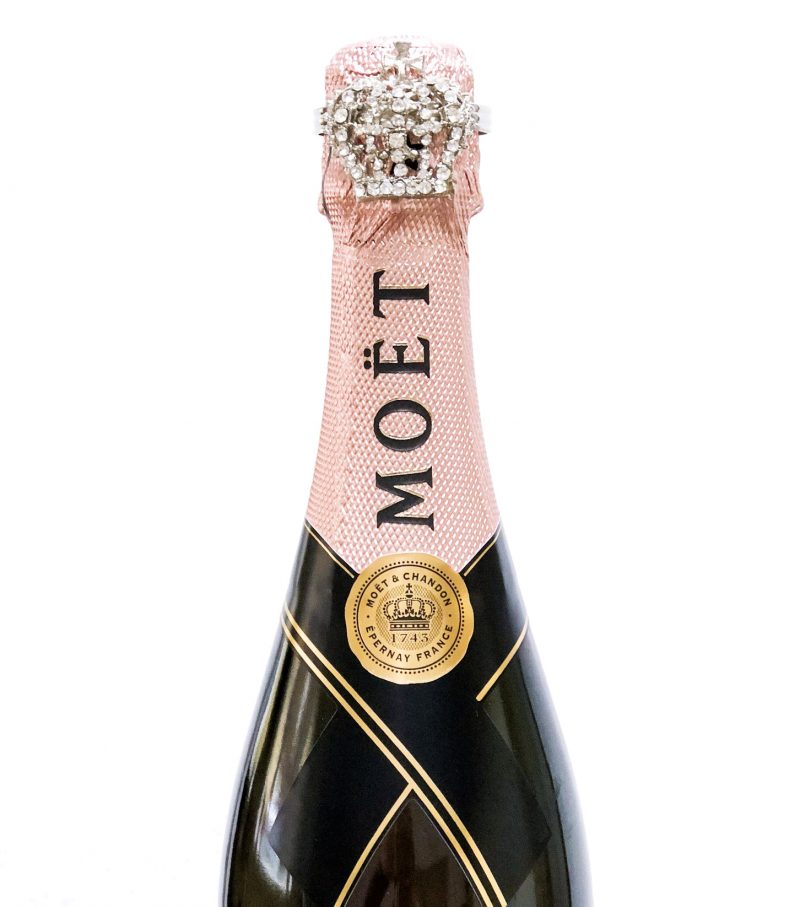
How do Shannon and I choose our champagne? It all started with the age-old practice of judging a book by its cover. I picked a bottle of Moët & Chandon Brut Rosé Champagne off the shelf because it was pretty. It was also a Brut Rosé, which I knew enough to guess we’d like. That, paired with the hefty (at that time in my life) price tag of $75CAD, indicated that it was well suited to our special occasion. To this day, it remains our favourite champagne and we couldn’t think of a better bottle to recommend.*
WHAT TO USE
Now that you’ve chosen your champagne, what should you serve it in? You are probably used to drinking champagne from the tall narrow champagne flute, but rest assured, there are other choices than this! The coupé, otherwise known as the bowl or saucer, has a vintage Gatsby-flair that might be more appealing to your eye. What is important to remember when choosing is that each style will impact the amount of bubbles and the taste. A narrow flute will allow more bubbles to accumulate, while a wide coupé will naturally disperse the bubbles, and thus the aromas, across the surface of the liquid. Flute enthusiasts note that the shape allows the bubbles to continually rise and collapse, which act as a continuous lift of aromas in your glass[6], while it is thought that the open bowl shape of the coupé was once favored because the mousse, or bubbles, were considered vulgar, and I tend to agree with that sentiment[7].
No matter your preference, here is a great info-graphic that will help you choose[8]:
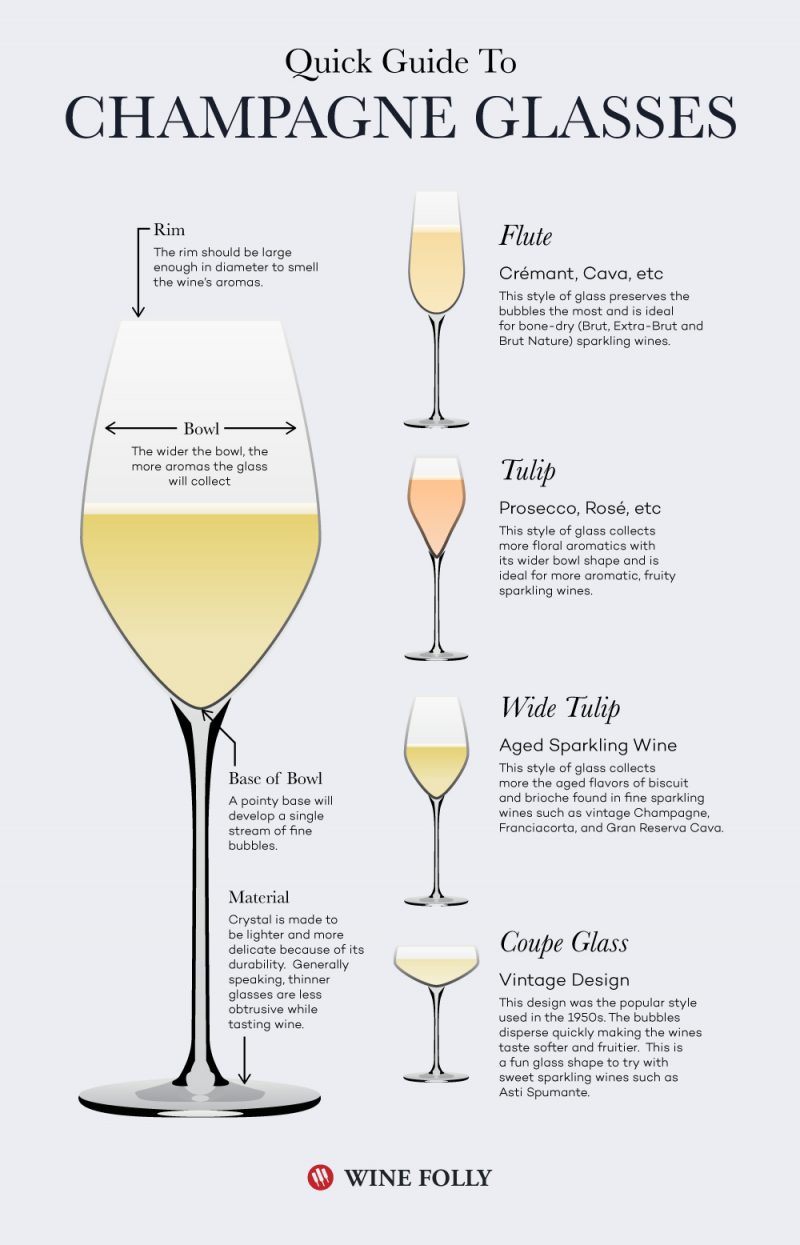
HOW TO OPEN THE BOTTLE
Sprays of foam spewing forth from your bottle is most unchic. To open your bottle the safest way, twist the little metal tie holding it in place and gently remove from the cork. Grab a tea-towel and hold it over the cork, nestling it into the palm of your hand. Like turning a doorknob, use your thumb and fingers to wiggle the cork slowly back and forth. If you keep your palm firmly overtop, it should pop off with no more than a muffled noise and a bit of pressure in your hand.
To open your bottle in a more dramatic fashion, open a window or door and grasp the neck of your bottle with both hands, aiming the cork outside. Hold the neck tightly and use both thumbs on either side of the cork to push the cork up. After a few dubious looks from your fellow onlookers, and a ducked head or two, the cork should eventually shoot out of the bottle with a resounding “POP” and out into the world. If you don’t trust your aim, or if you don’t have an 18th century Chateau window to aim your bottle out of, perhaps stick to the first method.
ETIQUETTE Q&A
- How should I hold my glass?
- Always hold your glass or flute by the stem. Holding it by the “bowl” warms your drink, and both white wine and sparkling wine taste best when chilled. Instead of holding the bowl, pinch the stem between your index finger and thumb.
- Do you ever put a cube of ice in your glass?
- I often do for my wine, in the privacy of my own home of course, and only if my wine isn’t cold enough. It’s OK if you do, but for goodness sakes, don’t do it to your champagne! Unless, of course, it is a glass of Moët and Chandon Ice Impérial, the first Champagne designed to be sipped over (three, at maximum) ice cubes.
- What accoutrements should accompany my bottle?
- Always serve your champagne chilled, and keep it in an ice bucket near the table once opened, if you know you will be finishing the bottle within the course of the meal.
- What if I want to save it for later?
- If you have, quel dommage, leftover champagne, simply store it in the fridge with the stem of a small spoon stuck in the open spout. I was taught this trick by a Parisian family I lived with during my Au Pair years; according to them, this will preserve the bubbles, and who am I to argue with the French?
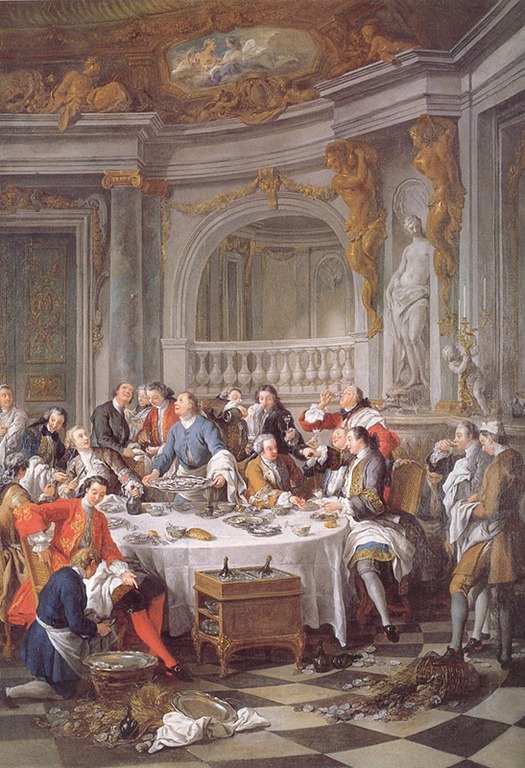
BEFORE YOU GO
I hope this guide has given you the right balance of history and practicality, but if your head is still spinning with all the different types and terms, and you feel more confused than ever, just consider the following painting:
Louis XV’s private dining room had this painting hung on the wall, which depicts a post-hunt oyster lunch, but more importantly it is a Champagne action scene. When in doubt, just look to the experts for guidance when it comes to enjoying Champagne. From the cork flying in mid-air above the man who just popped the bottle, to the buckets of oysters that have fallen to the wayside, there are wonderful little details all throughout the painting that remind us what Champagne is for: celebrating anything in extravagance and style. And as Madame de Pompadour once supposedly said, “Champagne is the only drink that leaves a woman still beautiful after drinking it.” [9]
Image right: Jean-François de Troy (1679–1752), Le Déjeuner d’Huîtres, 1734
Do you have any questions about the proper way to drink and serve champagne or anything else we’ve covered here?
Let us know in the comments!
*this is not a sponsored endorsement for Moët…though we wish it was!
[1] https://en.wikipedia.org/wiki/History_of_Champagne [2] http://www.lcbo.com/lcbo/product/dom-perignon-brut-vintage-champagne/280461#.Wj_8sCPMyRs [3] http://www.lcbo.com/lcbo/product/jacob-s-creek-moscato-rose-sparkling/445825#.Wj_8eSPMyRs [4] https://vinepair.com/wine-101/learn-about-sparkling-wines/ [5] https://www.epicurious.com/archive/drinking/wine/champagnebuyingtips [6] http://www.decanter.com/wine-news/champagne-bubbles-improve-flavour-64925/ [7] https://www.invaluable.com/blog/champagne-glass-history/ [8] http://winefolly.com/tutorial/champagne-flutes-or-glasses/ [9] https://food52.com/blog/12220-from-cup-to-coupe-a-history-of-our-favorite-champagne-glass
First of all, happy new year ! and congratulation on your blog opening, it looks lovely and having seen some images of Shannon’s home decoration talent I had to follow if only for that.
Now on to the current post, which is very well written and a good approach on how to drink Champagne (I too like Rosé especially as an “aperitif” rather than with a meal), but without trying to “split hair in four” as we french say, I had to make a couple additions to it (hopefully without sounding too pedantic which is a pretty common flaw from my people when it comes to food and beverages).
The first and important one is, the myth of the spoon in the spout is actually just that, a myth (and a persisting one at that). The original one was even specifying that the spoon had to be made of silver for it to work, but it’s been refuted multiple times by now even if a lot of my fellow french people cling to this belief.
The second is more of a bit of trivia and a tip that many of us in the trade learn from experience. While opening your bottle, if you don’t want to “pop” your cork, it is better to hold the bottle by its body rather than its neck as holding the neck will warm up the gas inside it, expanding it and making it harder to prevent the cork from escaping your grasp and more likely for the dreaded mousse geyser to happen.
Once again, very nice blog and I look forward to the future content.
Author
Oh wow! Thank you for that extra information! We were wondering about the ol’ spoon thing since it also seems heavily debated online. The tip about not holding the neck is brilliant also! Cheers and Happy New year!
Wonderful post, so timely and informative. Can’t wait to try out some of the suggestions and entertain guests with the Vivid history and etiquette of Champagne!
Jess, darling, any praise from you is so appreciated – we’re glad you enjoyed the article!
Very informative and helpful! Well written, Angela. You certainly know your stuff!
Thank you Hannah!
I’ve been looking forward to this launch for a while now, i can’t wait to see what you will produce for this blog. Here’s to 2018!! 🎉
Thank you for sticking with us Kieran, we hope you enjoy it!
I feel I leave here learning more about Champagne than when I opened the page. So thank you.
Zach, we are glad you learned something about Champagne, and hope you come back for more informative articles!
I thought I knew how to drink sparkling wine thanks to a few wine tastings, but I this post certainly proved me wrong.
Jonathan, we are always searching to expand our knowledge, and in researching this article we learned more than we thought too 🙂
Hello ,
I saw your tweet about animals and thought I will check your website. I like it!
I love pets. I have two beautiful thai cats called Tammy(female) and Yommo(male). Yommo is 1 year older than Tommy. He acts like a bigger brother for her. 🙂
I have even created an Instagram account for them ( https://www.instagram.com/tayo_home/ ) and probably soon they will have more followers than me (kinda funny).
I have subscribed to your newsletter. 🙂
Keep up the good work on your blog.
Regards
Wiki
Thank you for checking out the website Wiki, and hello to Tammy and Yommo 🙂